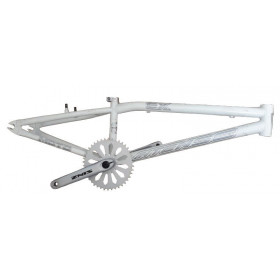-
 New productSticker Haro BMX
New productSticker Haro BMX- €1.29
-
 UsedBMX race Intense MOTO EX frame
UsedBMX race Intense MOTO EX frame- €49.99
Showing 1-2 of 2 item(s)
Manufacturing a BMX race frame: features and specificities
The BMX Race frame is the core component of the bike, defining its stiffness, lightness, and handling on the track. Designed for speed, explosive sprints, and jumps, it stands out thanks to precise technical choices and high-end materials. Let’s dive into how a BMX Race frame is made and what makes it unique.
The manufacturing process of a BMX race frame
The manufacturing of a BMX Race frame starts with material selection. Specialized brands usually choose between:
-
Aluminum: lightweight and stiff, it’s the most common material in competition. It offers a great balance between performance and cost.
-
Carbon fiber: less common and more expensive, it appeals to riders seeking extreme stiffness and ultra-lightweight builds.
-
Chromoly steel: less used in racing but still present on some entry-level models or for riders looking for more comfort.
The manufacturing process includes:
-
Tube cutting: each tube is precisely cut to ensure perfect assembly.
-
Tube forming: some tubes are bent or hydroformed to optimize geometry and strength.
-
Welding: the tubes are joined using TIG welding or, for carbon frames, by bonding and molding.
-
Heat treatment: aluminum frames go through a heat treatment to improve strength and durability.
-
Finishing: sandblasting, painting, and clear coating give the frame its final look.
Technical features of a BMX race frame
A quality BMX Race frame stands out with several key features drawn from the bike frame vocabulary:
-
Geometry: top tube length, head angle, reach, and chainstay length all influence handling, stability, and responsiveness.
-
Head tube diameter: designed to fit a BMX headset, often integrated or semi-integrated to accommodate modern forks.
-
Bottom bracket shell: must be compatible with the BMX crankset, commonly in Euro or Press Fit format.
-
Rear dropouts: engineered to hold the BMX wheels axle securely with perfect alignment.
-
Brake mounts: specifically designed for BMX brakes, typically V-brake or disc brake depending on the model.
Specific features of a BMX race frame
Every detail matters when designing a BMX Race frame:
-
Optimized weight: a Pro size aluminum frame typically weighs between 1.3 kg and 1.7 kg.
-
Lateral stiffness: essential for transmitting every ounce of the rider’s power during starts and sprints.
-
Component compatibility: the frame must fit a rigid BMX fork, a short and reinforced BMX seatpost, a precise BMX headset, and of course, a strong BMX crankset.
-
Cable routing: usually external for easy maintenance, with specific guides for the rear BMX brake cable.
How to choose your BMX race frame ?
Choosing the right frame depends on several factors:
-
Rider’s size: from Mini to Pro XXL, there’s a frame size for every rider.
-
Skill level: beginner, experienced amateur, or elite racer.
-
Track type: some geometries suit technical tracks with many jumps, while others are better for fast, flowy tracks.
Also, make sure to check compatibility between the frame and other components: BMX fork, BMX wheels, BMX crankset, BMX headset, as well as the BMX seatpost and BMX brakes.
Conclusion
The BMX Race frame is much more than just a structure: it’s the heart of the bike, the starting point of every explosive sprint and every jump in competition. Its design and build meet the highest demands for performance, reliability, and adaptability. Whether you’re a beginner or a seasoned racer, understanding the features of a BMX Race frame will help you make the right choice and boost your performance on the track.
